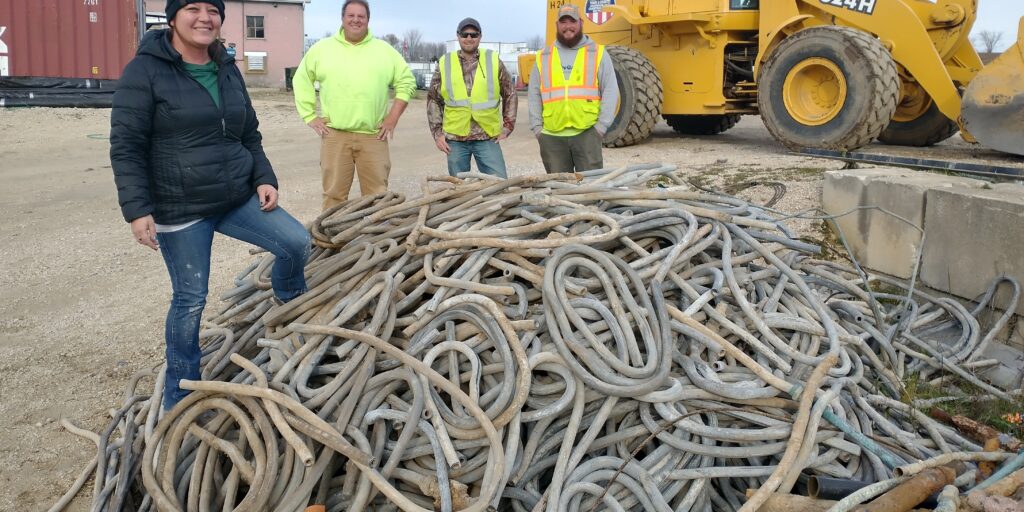Getting the lead out: Courtney Steger, 2022 Exemplary Public Servant of the Year
Exposure to lead through drinking water in homes continues to be a major public health issue in the United States, and while replacing lead pipes is a costly and time-consuming project for any size community, it’s necessary for the health and wellbeing of residents. That is why Courtney Steger, utilities director of Mayville, Wisc., knew that it had to be done in her town. After running quality tests required by the Wisconsin’s Department of Natural Resources (DNR), they found that one of the test sites in Mayville had an extremely high lead number, which launched the town into an exceedance with the DNR. Steger explains: “We had to make a choice to either remove every piece of lead in the city or start looking into corrosion control treatment, and things like adding some more chemical to the system, which we didn’t want to do. So we just said, ‘we’ll take them all out.’”
Steger’s determination and success in removing and replacing all of the lead service laterals in Mayville is why she has been selected as one of American City & County’s 2022 Exemplary Public Servant of the Year.
In a recent survey, the Environmental Protection Agency (EPA) found that more than 9 million homes across the country have lead pipes. In 2021, the Biden administration announced the Biden-Harris Lead Pipe and Paint Action Plan under the Bipartisan Infrastructure Law to allocate funds and to collaborate with local, state and federal partners to accelerate the replacement of lead pipes over the next decade.
The process for removal in Mayville started in 2021, in the middle of the COVID epidemic. According to Steger, there was not a lot they could do as far as meeting with constituents, but they were able to secure a grant through the Infrastructure Law to cover the cost of removal and replacement of lead service laterals to homes and public places. Mayville has about 2,100 residences (population is approximately 5,100), and Steger asked in the grant application that they get enough to cover the project completely.
“We didn’t believe we’d have as much cooperation if this wasn’t 100 percent paid for,” she said. “Essentially [the grant] was through the EPA, and then the EPA handed out to individual states to disperse the funds, so in Wisconsin, it’s the DNR that disperses advantages.”
Mayville had to apply for an additional grant for the project in 2022. “We did complete it all in a year,” Steger explains. “We did apply again because we went over our grant fund. The next set retroactively paid whatever we were over, and then we’ve had a couple incidentals since then that we found and today we’ve completed those all again.”
All totaled, Mayville received $1.5 million in grants.
So, how does one go about finding and replacing lead service lines throughout the town, in people’s private homes? With a lot of community cooperation. Steger says they found some older records from the 1970s and ’80s that “sometimes indicated there was lead, and sometimes it didn’t.” They put out videos showing what lead pipes look like, and asked people to check their pipes.
“We had [residents] taking cell phones down to the basement and crawling down on the floor with a screwdriver, and we were like ‘Can you tell me what you’re seeing right now?’” Steger says. Because it was still COVID and people were distancing, they had neighbors calling to other neighbors from the sidewalk about checking for lead pipes. “It was kind of fun to watch, almost like a community gossip—’did you check yours? did you check yours?’—but it was nice to see that people were concerned about it and checking on their neighbors and checking on their families,” Steger says.
Most of the houses with lead service lines in Mayville were built between 1910 and 1940. “We did recognize a pattern at one point,” Steger says. “We could tell the potential for lead service based on the foundation. There was a certain type of split block that we noticed always coincided with lead water service.” Steger says her team member joked that spotting houses with lead pipes was becoming her superpower.
Working with local contractors Town and County Underground Utility Construction Inc. and plumbers Bernhard Plumbing, the replacement project started in March 2021 and was completed in November of the same year. “Our contractors were extremely helpful,” Steger says. “They were all in on getting this project done, so we never would have without their dedication.”
Using thermoplastic HDPE (high-density polyethylene) pipe, the team was able to set up a system “where they could pull the old lead pipe out then pull the poly right behind it,” Steger explains. “So, in some cases they didn’t necessarily have to dig to do it. It was a really creative method that they came up with, and helped the project go little faster.” They were able to do one or two houses a day, and replaced all 230 of Mayville’s lead service lines.
Reflecting on how removing lead service lines from Mayville benefited the community, Steger recalled one of the first houses they worked on, where the youngest child always had a high level of lead in her blood “to the point that they wanted to hospitalize her. And seven months to the date after we replaced that lead service in their home, she had a blood lead test, and for the first time in her life she had normal levels. That one made it worth it entirely to me. I’m sure she’s not the only one, but she’s the prime example.”
Steger is humble about taking credit for spearheading the lead removal project in Mayville, but she knows how important getting the lead out is. “It’s a huge scary task, and I want to promote this as much as I can,” she says. “I know we’re done with this project, but it’s a huge problem in the U.S., and I guess I’m pretty passionate about it. There needs to be more funding, more grants. Everybody buckle up and you just have to go for it. It is the only way it’s going to happen, right? Oh yeah, I promote it endlessly.”

















